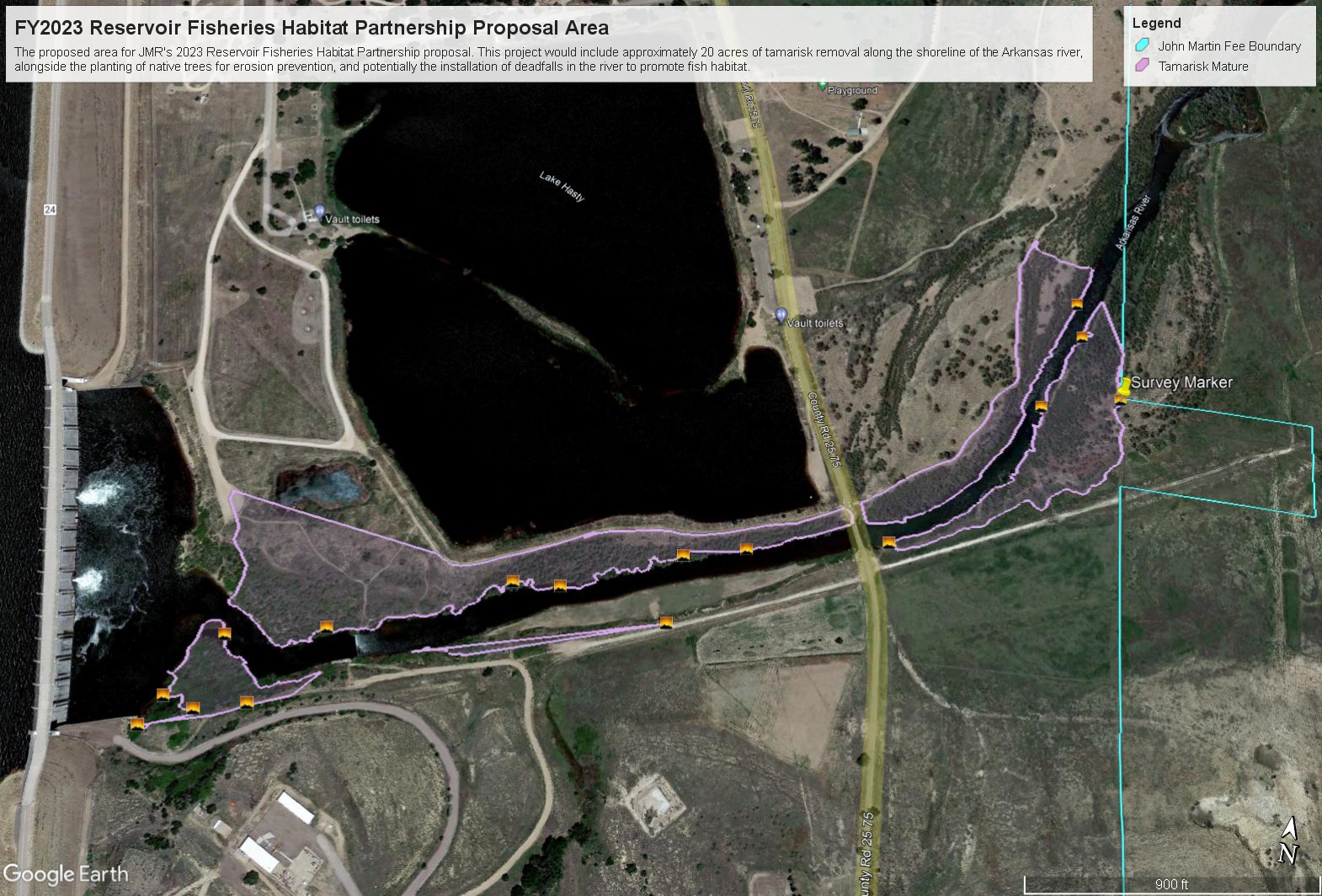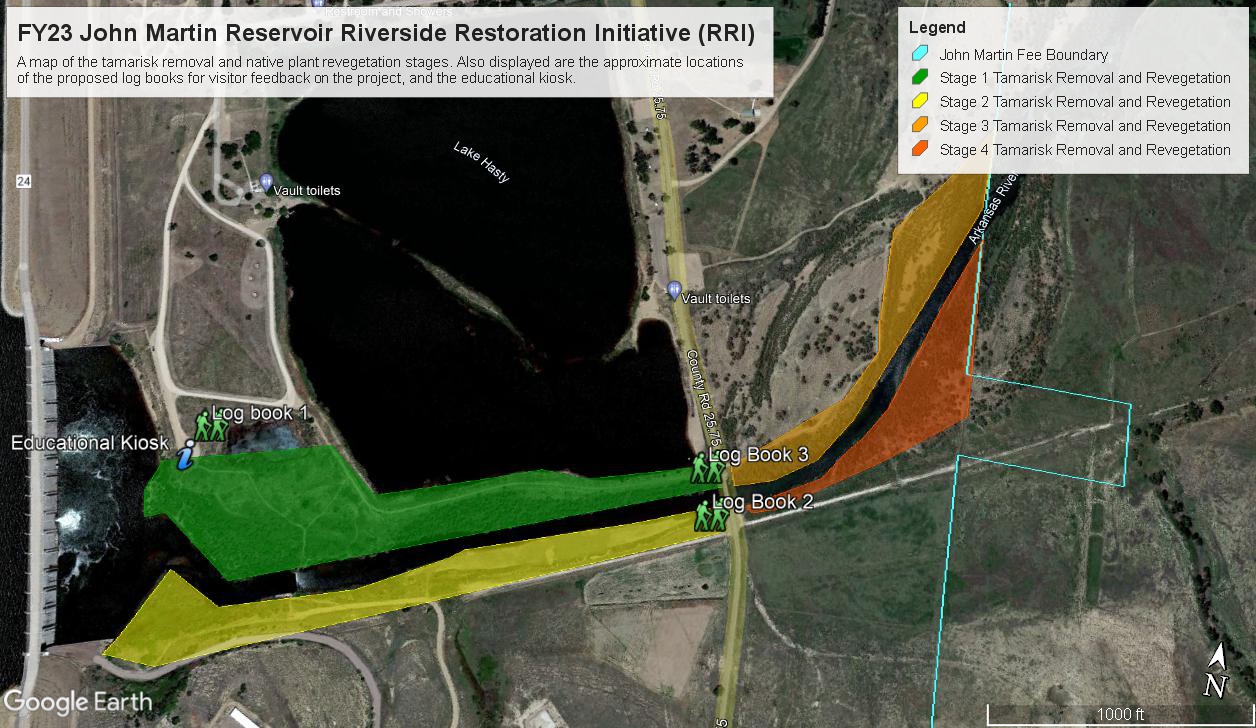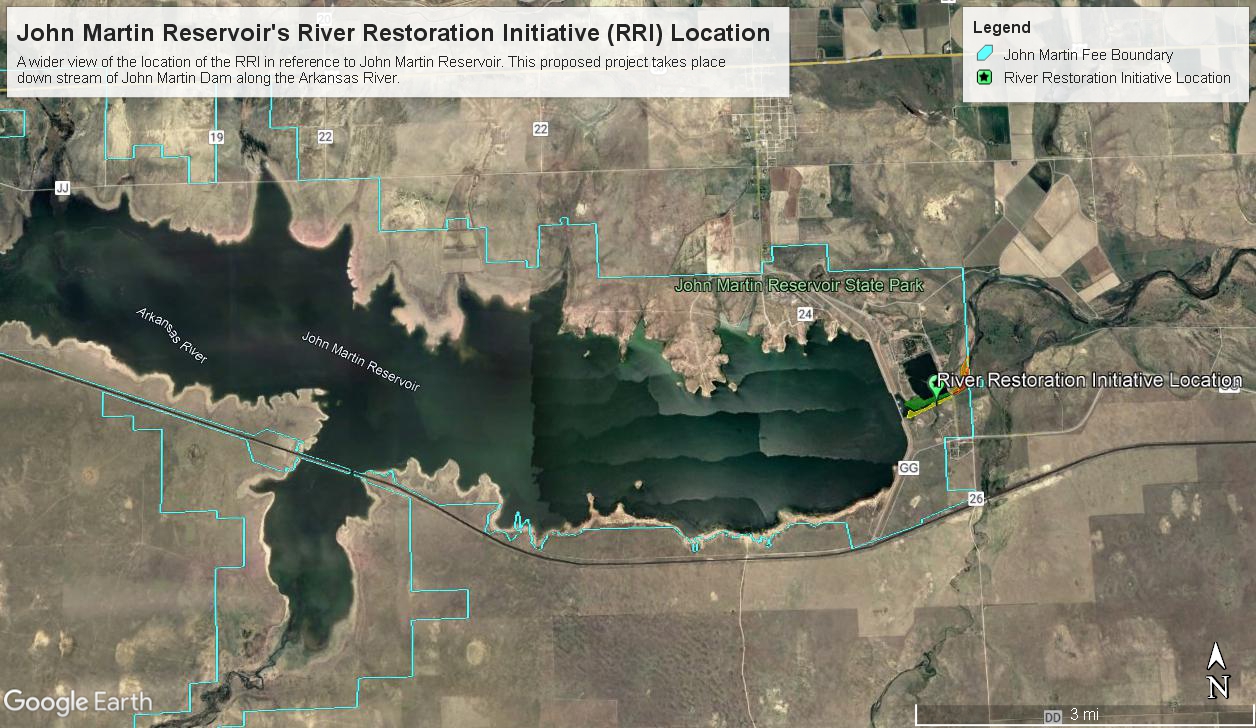John Martin Reservoir
John Martin Reservoir Riverside Restoration Initiative (RRI)
FOR Member/Group Sponsoring the ProjectU.S. Army Corps of Engineers
Construction of John Martin Dam began on the Arkansas River in 1939. The dam was originally authorized to protect the Arkansas River Basin from floods and to conserve and provide water to eastern Colorado and western Kansas for irrigation. Construction of the dam was halted from 1943 to 1946 due to World War II and completed in 1948. John Martin Reservoir (JMR) is the collective area name for all U.S. Army Corps of Engineers (USACE) owned land surrounding the Reservoir itself, which totals approximately 25,000 acres. This biodiverse area, known informally as the Sapphire on the Plains, is the wintering home for thousands of migratory birds and is seasonally a local tourism hotspot.
Following the construction of the dam, introduced tamarisk (Tamarix ramossima) rapidly spread across the land surrounding the reservoir and river. The tamarisk infestation at JMR is worse than any other place in the state of Colorado, with an estimated 43% of the project area covered with the invasive species. Tamarisk is an invasive five to twenty-foot shrub that grows in dense thickets, spreads through both seeds and propagation, and can live up to 100 years. Originally brought to the United States for erosion control, tamarisk has thrived in the moist sandy soils adjacent to waterways and has rapidly and noxiously spread across the United States.
Tamarisk has negatively impacted wetlands at John Martin Reservoir in numerous ways. The dense vegetation has degraded much of JMR’s wetlands, replacing native vegetation and habitats with thick growth that produces much more shade than historically present in the area. The presence of tamarisk in the reservoir increases the risk of wildfires, reduces native species habitat and biodiversity, and channelizes the waterways to account for the inability of the river to naturally alter its course. The dense growth of tamarisk affects the shade of the river, and therefore temperature, impacting the habitability of the waterway. In addition to this, tamarisk is known for making the soil more alkaline, which also has a negative impact on fish habitat health. In addition to this, tamarisk’s dense growth essentially cuts off much of JMR’s water access to anglers and recreationists, negatively impacting the public’s ability to engage in JMR’s aquatic recreation opportunities.
This initiative seeks to improve wetland and aquatic habitat adjacent to the Arkansas river down-stream from John Martin Dam across 40 acres of land, including 20 acres of tamarisk removal. The area selected for this project is home to three especially important species of fish, the state endangered suckermouth minnow, the state threatened Arkansas Darter, and the Flathead Chub, which is a species of concern in the state of Colorado. Our proposed project to benefit these fish species and local recreationists would be accomplished through group efforts with Colorado Parks and Wildlife using a combination of hand tools, mechanized equipment, and Garlon 3A herbicide. This habitat removal work would take place over two and a half years seasonally, through the fall to spring, to avoid disturbing the area during tamarisk’s flowering season.
The U.S. Army Corps of Engineers is working on managing the tamarisk issue at John Martin Reservoir, with projects underway in several locations. The River Restoration Initiative (RRI) proposed in this project would not only allow USACE to treat a much needed area down stream of John Martin Dam, but would also have a direct impact on the accessibility of this section of the Arkansas River for local and visiting anglers. Our project's outreach plans will also allow us to communicate with the public about invasive species and wetland ecosystem health. This project will also help to mitigate climate change effects on the fishery. As tamarisk is a water intensive plant that channelizes rivers, its removal will assist in water conservation efforts within the Arkansas River Basin.
Tamarisk removal from this forty-acre section of land would be broken into four sections, with the areas west of County Road 25.75 prioritized first due to their greater potential for recreation usage. As each section of the project area has removal efforts completed, restoration efforts of native vegetation will be implemented. Native species of grasses and forbs, cattails, willows, and cottonwoods will be planted along the banks to control erosion and spot treatments for re-emerging tamarisk will be completed.
- The removal of 20 acres of invasive tamarisk from across 40 acres of shoreline adjacent to the Arkansas River.
- The revegetation with native forbs and trees for a healthy wetland and erosion control.
- Better access for anglers to the waterway for recreational purposes.
- Direct improvement to the wetland habitat through a return to native vegetation.
- Direct improvement to river health through removing dense tamarisk growth that causes channelization, lower water temperatures, and more alkaline soils.
Through the completion of this project, 4,0000 feet of river and 40 acres of land will be protected from invasive species, with approximately 35 acres of tamarisk removed, and native vegetation replanted throughout. This project will be completed in four sections, each improving river access and wetland habitat.
In Stage 1, tamarisk will be removed and native vegetation replanted west of County Road 25.75, along the north side of the Arkansas river. This Stage covers to restoration of 14 acres of land adjacent to the State Park’s campground, which we predict will receive the largest increase in angler use. In addition to this, during Stage 1, Angler Logbooks will be installed at three access locations in the project area and the educational kiosk will be constructed on the western end of the project area.
In Stage 2, tamarisk will be removed from approximately 9 acres of land west of County Road 25.75, along the south side of the Arkansas river. This strip of land is also used by anglers. If cattail wetlands can be established, after the removal of tamarisk, this area could provide habitat for the federally threatened eastern black rail (Laterallus jamaicensis jamaicensis).
For both stage 1 and 2, which are located west of County Road 25.75, JMR has permission to utilize mechanized tools for tamarisk removal. We will be coordinating with local experts to choose the best equipment for large scale vegetation removal with minimal soil disturbance for these two areas. Once these areas are replanted, they will continue to be monitored and we will implement targeted retreatment of tamarisk saplings in order to ensure native species establishment.
In Stage 3, tamarisk will be removed by chainsaw and native vegetation restored on approximately 7 acres of land east of County Road 25.75 and north of the Arkansas River. This land contains potential habitat for the eastern black rail, which would be made more suitable with the removal of invasive tamarisk and supplemental planting of native species.
Finally, in Stage 4, tamarisk will be removed by chainsaw and native vegetation restored on approximately 5 acres east of County Road 25.75 along the south side of the Arkansas River. This stage contains some of the most dense tamarisk vegetation in the project area. In many spots, the vegetation here is so thick that it is not possible to traverse by foot.
By the end of stage 4 tamarisk removal, we will have a good idea of how native vegetation is doing in stage 1 and 2 areas, and can reassess and adapt our management plans accordingly. We anticipate continued monitoring and spot retreatment to be needed on an ongoing basis to prevent tamarisk from re-establishing in the area.
We will be successful when we remove 35 acres of mature tamarisk growth. Additional measures of success include minimizing the total needed retreatment area to less than 10% annually, having at least 50% native vegetation recolonization by year 5, and overall improved quality of fish habitat and soil health.
Prior to the onset of the Riverside Restoration Initiative (RRI), JMR Ranger Staff will conduct species surveys of the project area to record the diversity and abundance of wildlife using the area. These data will be used as a baseline to monitor for changes in biodiversity to the area.
Immediate evaluation metrics for the RRI will be based on the pound of invasive species removed, the acres of native vegetation replanted, and the acres of river access restored. These evaluation metrics will allow for the immediate appraisal of the project. Over time, continued success will be determined by measuring the number of acres needing retreatment, the acreage of native vegetation that has been recolonized, and overall improvements to fish habitat and soil health.
Other long-term monitoring strategies to quantify the outcomes of this project will include annual species surveys, angler usage of the site determined by CPW’s visitor counts, and visitor satisfaction recorded in logbooks.
Our Outreach Plan consists of a social media campaign, volunteer recruiting and education, informal contact with JMR’s visitors, and an educational kiosk. Our social media coordinator will work to carry out a communications campaign promoting our efforts and educating the public about invasive species removal. The main messages of the campaign will be about the importance of controlling invasive species and the benefits to fish and wildlife from restoring native vegetation.
Throughout the social media campaign, we will update people on our progress removing tamarisk and encourage them to volunteer their help for native plant revegetation. We will give all volunteers a brochure about native Colorado vegetation and seed balls that contain native Colorado seeds, to plant native Colorado wildflowers at their own homes. We hope this helps improve the uptake of our communications messages, makes their learning more tangible, and fosters positive relationships with the local community.
As the proposed project area lies adjacent to Colorado Parks and Wildlife’s State Campground, there are numerous opportunities for outreach and education to visitors. In addition to the implementation of the logbooks at parking lots and river access points, CPW Ranger staff will be able to communicate the utility of the project to campers, letting them know why we’re doing the project, and how they can help.
Following the completion of stage 1 of the RRI project, an educational kiosk will be constructed at the west parking lot of the project area. This kiosk will educate the public on the multi-agency project we undertook and memorialize the support we received from the FY23 Habitat Fisheries Grant.




